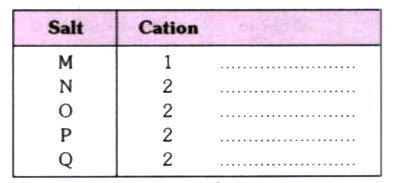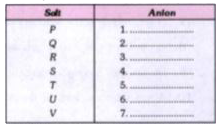A solution of a salt in water, on addition of dilute HCI, gives a white precipitate, which is soluble in hot water. The salt contains
Fe2+
Hg2+
Ag+
Pb2+
The correct Answer is:D
To solve the problem step by step, we need to analyze the information given about the salt and its behavior when treated with dilute HCl.
Step 1: Understand the Reaction
We have a salt that, when added to dilute hydrochloric acid (HCl), produces a white precipitate. This indicates that the salt contains a cation that forms an insoluble chloride.
Hint: Consider common salts that form white precipitates with HCl.
Step 2: Identify the White Precipitate
The white precipitate formed upon the addition of dilute HCl could be due to the formation of silver chloride (AgCl) or lead(II) chloride (PbCl2). Both of these compounds are known to precipitate as white solids.
Hint: Recall the solubility rules for chlorides to determine which precipitate is relevant.
Step 3: Analyze Solubility in Hot Water
The problem states that the white precipitate is soluble in hot water. Among the two potential precipitates:
- AgCl is insoluble in hot water.
- PbCl2 is soluble in hot water.
This means that the salt must contain lead (Pb) as the cation.
Hint: Look for the solubility characteristics of the precipitates formed.
Step 4: Conclusion
Since the precipitate is soluble in hot water, we conclude that the salt contains lead(II) ions (Pb²⁺). Therefore, the correct answer is that the salt contains Pb²⁺ ions.
Final Answer: The salt contains Pb²⁺ ions.
Summary of Steps:
1. Identify the reaction with dilute HCl and the formation of a white precipitate.
2. Determine the possible white precipitates (AgCl and PbCl2).
3. Analyze the solubility of these precipitates in hot water.
4. Conclude that the salt contains Pb²⁺ ions based on the solubility information.
We have a salt that, when added to dilute hydrochloric acid (HCl), produces a white precipitate. This indicates that the salt contains a cation that forms an insoluble chloride.
The white precipitate formed upon the addition of dilute HCl could be due to the formation of silver chloride (AgCl) or lead(II) chloride (PbCl2). Both of these compounds are known to precipitate as white solids.
The problem states that the white precipitate is soluble in hot water. Among the two potential precipitates:
- AgCl is insoluble in hot water.
- PbCl2 is soluble in hot water.
Since the precipitate is soluble in hot water, we conclude that the salt contains lead(II) ions (Pb²⁺). Therefore, the correct answer is that the salt contains Pb²⁺ ions.
1. Identify the reaction with dilute HCl and the formation of a white precipitate.
2. Determine the possible white precipitates (AgCl and PbCl2).
3. Analyze the solubility of these precipitates in hot water.
4. Conclude that the salt contains Pb²⁺ ions based on the solubility information.
Similar Questions
An aqueous solution of a substance, on treatment with dilute HCl, gives a white precipitate soluble in hot water. When H2S is passed through the hot acidic solution, a black precipitate is formed. The substance is:
View SolutionSalts M, N, O, P and Q undergo reactiom (i) to (v) respectively.
Identify the cation present in these salts on the basis of these reaction. Tabulate your answer in the format given below.
1. When sodium hydroxide solution is added to the salt M, and heated strongly a colourless gas with a pungent smell is evolved which turm red litmus paper blue and gives dense white fumes with a moist glass rod with hydrochloric acid.
2. Addition of dilute hydrochloric acid to a solution of N gives a thick white precipitate which is soluble in hot water.
3. When ammonium hydroxide solution is added to the solution of 0 a light blue precipitate is obtained which is soluble in excess of ammonium hydroxide to form an inteme deep blue solution.
4. When ammonium hydroxide solution is added to the solution of P reddish brown (mustard colour) precipitate is obtained which ,is insoluble even in the excess of ammonium hydroxide solution.
5. When sodium hydroxide solution is added to the solution of Q a which coloured gelatinous precipitate is obtained which is soluble in excess of sodium hydroxide to form a clear solution

View SolutionA white colored inorganic salt formed by an element fo group 14 give the following reactions :
a. It is soluble in water and the solution has sweet taste .
b. The salt when heated gives acetone and a yellow colored residue which is used in paints
. c. The solution of the salt gives a white precipitate with dil HCi which is soluble in hot water .
Explain the above observations with chemical reactions involved .
View SolutionIdentify the salts P & Q from the observations given below: i] On performing the flame test salt P produces a lilac coloured flame & its solution gives a white precipitate with silver nitrate solution, which is soluble in ammonium hydroxide solution. ii] When dilute HCl is added to a salt Q, a brisk effervescence is produced and the gas turns lime water milky. When NH4OH solution is added to the above mixture [after adding dilute HCI], it produces a white precipitate which is soluble in excess NH4OH solution.
View SolutionIdentify the salts Q from the observations given below:
When dilute HCl is added to a salt Q, a brisk effervescence is produced and the gas turns lime water milky. When NH4OH solution is added to the above mixture (after adding dilute HCl), it produces a white precipitate which is soluble in excess NH4OH solution.
View SolutionThe aqueous solution of salt gives white ppt with lead acetate solution which is insoluble in hot water and nitric acid .The salt contains
View SolutionA salt solution of Cd2+ in dilute HCl, on treatment with a solution of BaCl2 gives a white precipitate, which is insoluble in concentrated HNO3. Anion in the salt may be :
View SolutionA colourless solid A dissolves in water. The aqueous solution gives a white precipitate B when NaOH or NH4OH is added. B dissolves in excess of NaOH but not in excess of NH4OH. BaCl2 solution added to a solution of A gives a white precipitate C which is insoluble in dilute HCI. A may be
View SolutionSalts P, Q,R,S,T,U and V undergo reactions (i) to (vii) respectively. Identify the cation present in these salts on the basis of these reactions. Tabulate your answer in the formate given below.
(i) When the salt Pis heated with sodium hydroxide solution a vigorous reaction takes place and a colourless gas is evolved with a pungent and suffocating smell that brings tears in our eyes. The evolved gas gives dense white fumes with a moist glass rod depped with hydrochloric acid.
(ii) Addition of sodium hydroxide solution to a solution of salt Q gives a thick white precipitae which is soluble in excess of sodium hydroxide solution to form a clear solution.
(iii) Addition of ammonium hydroxide solution to a solution of salt R gives a dark blue precipitate which is soluble is excess of ammonium hydroxide solution to form an intense deep blue solution.
(iv) Addition of ammonium hydroxide solution to a solution of 5 gives a dirty green [bottle green] precipitate which is insoluble even in the excess of ammonium hydroxide solution.
(v) Addition of ammonium hydroxide solution to a solution of T gives a reddish brown (rust precipitate] precipitate which is insoluble even in the excess of ammonium hydroxide solution.
(vi) Addition of ammonium hydroxide solution to a solution of V gives a geletaneous white precipitate which is soluble in excess of ammonium hydroxide solution to form a clear solution.
(vii) Addition of ammonium hydroxide solution to a solution of V gives no precipitate but it gives a chalky white precipitate with sodium hydroxide solution which is insoluble even in the excess of sodium hydroxide solution.

View SolutionA compound (A) is greenish crystalline salt, which gave the following reactions.
(i)Addition of BaCl2 solution to the solution of (A) results in the formation of white precipitate (B) which is insoluble in dilute HCl.
(ii)On heating (A), water vapours and two oxides of sulphur (C) and (D) are liberated leaving a red brown residue (E).
(iii)(E) dissolves in warm concentrated HCl to give a yellow solution (F).
(iv)Solution (F) on treatment with thiocyanate ions gives blood red coloured compound (G).
Identify the compounds from (A) to (G).
View Solution
